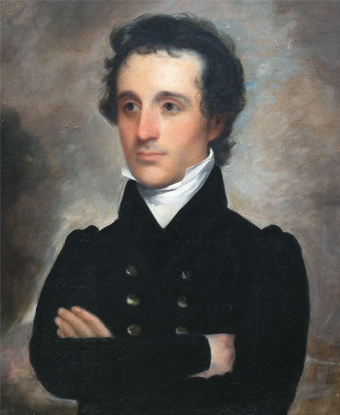Last updated: December 23, 2019
Person
William H. Chase

Painting by John Wesley Jarvis, used by permission.
In August 1828, the US Army Corps of Engineers chose Captain William Henry Chase to build coastal fortifications on Pensacola Bay. Chase, a talented engineer and businessman, transformed Pensacola from a remote coastal town into a bustling port.
Born in Massachusetts in 1798, Chase graduated from West Point at age 16. Over the course of his 42 years of service, Chase worked on projects across the nation.
Chase’s entry into the Corps of Engineers coincided with the building of Third System forts along the US coastline. Constructing Fort Pickens, Fort Barrancas, Fort McRee, and Advanced Redoubt became notable aspects of his career.
Time spent in the South led to his marriage to Anne Matthews, who came from one of the wealthiest slave-owning families in Louisiana. The marriage not only made Chase wealthy, but gave him privileges like never before.
Building forts in areas like Pensacola, at the time a frontier, was challenging. Chase wanted the best value for his money. Local brickmakers initially refused Chase’s prices, so he ordered the first shipment of bricks from Mobile. This forced brickmakers in Pensacola to lower prices to compete for contracts.
Chase also ordered items like lime, copper sheeting, and even Venetian blinds, boosting the town’s maritime shipping trade. Tired of relying on faroff banks in New Orleans, he became a founding partner in the Bank of Pensacola.
To build the forts, Chase relied on enslaved tradesmen owned by Underhill & Strong of New Orleans. These men had experience in fort building. Chase added to the workforce by advertising for rented slave labor from the local area. A sudden swelling of enslaved people under Chase’s directive changed the system of slavery in Pensacola. More slaves meant more wealth. Wealth led to a healthy and growing economy.
Chase spent 27 years constructing the Pensacola Bay forts. Though born in a northern state, he came to see himself as a southerner. In 1856, Chase resigned from the Army but kept busy growing Pensacola’s economy. Five short years later, the outbreak of the Civil War forced Chase to make a difficult decision. Should he return to his birthplace or align with the place and the people he loved in the Deep South?
Florida looked to Chase to lead the state’s militia in before the outbreak of the Civil War. State leaders tasked him with seizing the navy yard and negotiating the surrender of Union-held Fort Pickens. Chase had no hope of taking Fort Pickens by force because it was impenetrable—exactly as intended when he oversaw its construction 27 years earlier.
Though born in Massachusetts, Chase spent the majority of his life in the South. He planted roots in Pensacola, established his family and business practices in the city, and created a home on the Gulf Coast. The division of states during the Civil War affected Chase in unexpected ways. Chase’s enduring legacy, built in brick and mortar, are a testament to his impressive engineering skills and entrepreneurial spirit.
